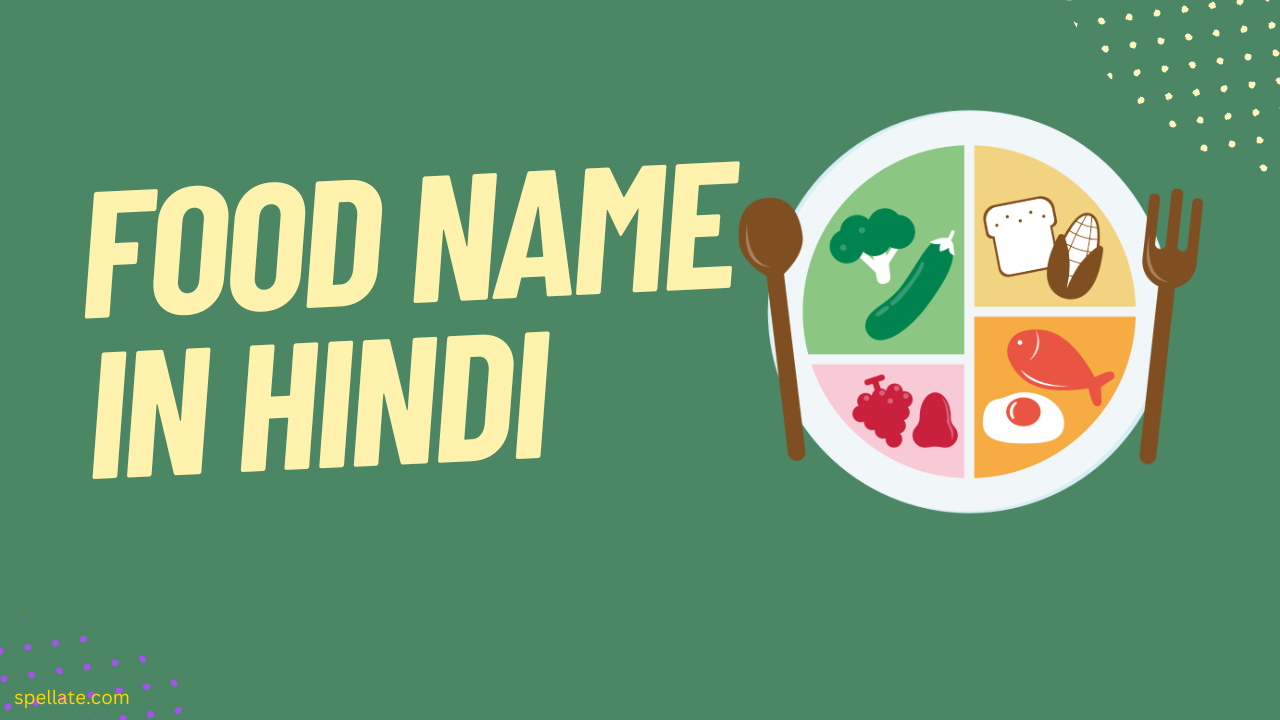India is a land of diverse cultures and cuisines, with each region offering its unique culinary delights. The Hindi language, one of the most widely spoken languages in India, boasts a rich vocabulary when it comes to food. Whether you are a food enthusiast, a traveler exploring the vibrant streets of India, or simply curious about the names of popular dishes, understanding the food name in Hindi can add a delightful dimension to your culinary journey.
The Hindi language, with its roots in Sanskrit, incorporates a wide range of words and phrases to describe various ingredients, cooking techniques, and traditional dishes. It beautifully captures the essence of Indian cuisine, showcasing the country’s deep-rooted cultural heritage and flavors.
Indian cuisine is known for its use of aromatic spices, vibrant colors, and a harmonious blend of sweet, savory, spicy, and tangy flavors. The food name in Hindi reflects the diverse and eclectic mix of flavors, making it a fascinating experience for those looking to explore Indian cuisine.
From the delectable street food items like “chaat” (a savory snack) and “samosa” (a crispy pastry filled with spiced potatoes), to the mouthwatering regional specialties like “biryani” (a flavorful rice dish) and “rajma chawal” (kidney beans with rice), the Hindi names of these dishes evoke a sense of nostalgia, culture, and culinary excellence.
The Hindi language also encompasses a wide range of food-related vocabulary, including terms for spices, herbs, grains, vegetables, fruits, and cooking techniques. Understanding these food names in Hindi can enhance your interaction with locals, help you navigate menus in Indian restaurants, and even assist you in recreating traditional Indian recipes in your own kitchen.
Whether you are planning a trip to India, trying out Indian recipes, or simply exploring the vast world of Indian cuisine, knowing the Hindi names of food will undoubtedly enrich your gastronomic experience. Join us on this delightful journey as we explore the vibrant and diverse world of food name in Hindi, discovering the flavors, aromas, and cultural significance behind each dish.
- Popular food name in Hindi
- Rajma Chawal – Kidney beans with rice:
- Chole Bhature – Spiced chickpeas with fried bread:
- Paneer Tikka – Grilled cottage cheese cubes:
- Biryani – Fragrant rice dish with meat or vegetables:
- Samosa – Deep-fried pastry filled with spiced potatoes or meat:
- Gulab Jamun – Deep-fried milk dumplings soaked in sugar syrup:
- Jalebi – Deep-fried spiral-shaped sweet treat:
- Masala Dosa – Rice and lentil crepes filled with spiced potato mixture:
- Butter Chicken – Creamy chicken curry:
- Aloo Paratha – Stuffed whole wheat bread with spiced mashed potatoes:
- Pani Puri/Gol Gappa – Hollow crispy puris filled with spicy and tangy water:
- Tandoori Chicken – Grilled marinated chicken:
- Palak Paneer – Spinach with cottage cheese:
- Dal Makhani – Creamy lentil dish:
- Vada Pav – Spiced potato fritters in a bread roll:
- List of 50 food name in Hindi and English
Popular food name in Hindi
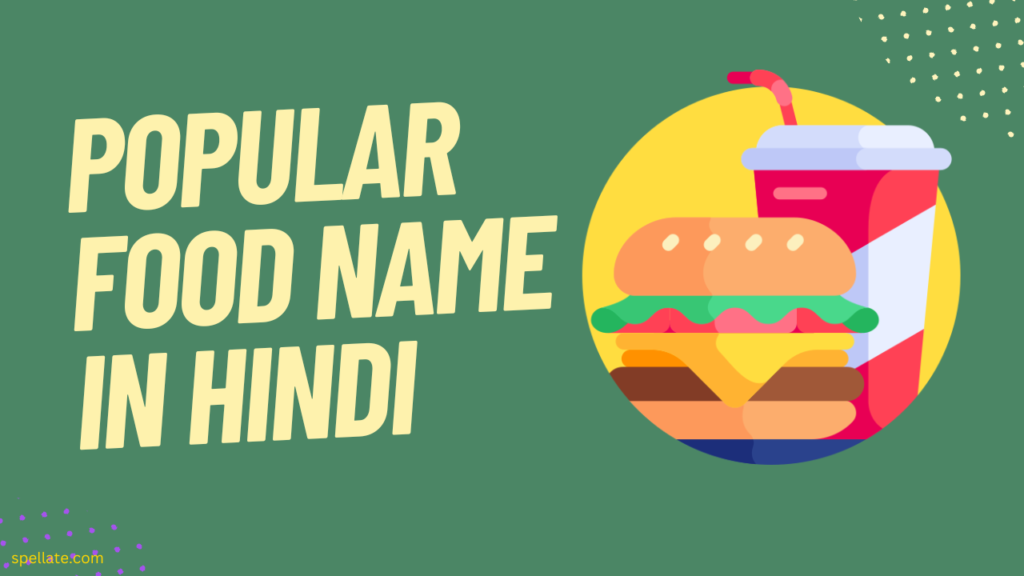
India is a country rich in culture, tradition, and cuisine. One of the many things that make Indian food unique is the use of spices and herbs that give each dish its distinct flavor. Hindi is one of the most widely spoken languages in India, with over 300 million native speakers. As such, it’s no surprise that there are several popular food names in Hindi.
Rajma Chawal – Kidney beans with rice:
Rajma Chawal is a popular North Indian dish that consists of kidney beans cooked in a flavorful tomato-based gravy, served with steamed rice. Rajma refers to the kidney beans, which are soaked, cooked, and then simmered in a rich and aromatic sauce made with onions, tomatoes, and a blend of spices. Chawal simply means rice. The combination of the creamy, protein-packed kidney beans with the fluffy rice creates a comforting and satisfying meal.
Chole Bhature – Spiced chickpeas with fried bread:
Chole Bhature is a beloved Punjabi dish that features spicy chickpeas (chole) served with deep-fried bread (bhature). Chole refers to the chickpeas, which are cooked in a tangy and aromatic gravy made with onions, tomatoes, ginger, garlic, and a medley of spices. The bhature is a soft, fluffy bread made from fermented dough, typically deep-fried until it puffs up and turns golden brown. Combining the spicy chickpeas and the indulgent fried bread creates a delightful and filling meal.
Paneer Tikka – Grilled cottage cheese cubes:
Paneer Tikka is a popular vegetarian appetizer in Indian cuisine. Paneer refers to Indian cottage cheese, which is cut into cubes and marinated in a mixture of yogurt, spices, and seasonings. The marinated paneer cubes are then skewered and grilled or baked until they are lightly charred and have a smoky flavor. The result is tender and flavorful cottage cheese cubes with a slightly crispy exterior. Paneer Tikka is often served with mint chutney and makes for a delicious and protein-rich snack or starter.
Biryani – Fragrant rice dish with meat or vegetables:
Biryani is a highly cherished and flavorful rice dish that originated in the Indian subcontinent. It is a one-pot dish that combines aromatic basmati rice with a blend of spices, meat (such as chicken, lamb, or beef), or vegetables. The dish is typically prepared by cooking the meat or vegetables separately with a mix of spices and then layering it with partially cooked rice. The layers are then sealed and cooked on a low flame, allowing the flavors to meld together. The result is a fragrant and flavorful rice dish with tender meat or vegetables, infused with spices like cumin, coriander, cardamom, and saffron.
Samosa – Deep-fried pastry filled with spiced potatoes or meat:
Samosa is a popular savory snack that has gained immense popularity not only in India but also worldwide. It consists of a triangular or cone-shaped pastry made from a dough typically composed of all-purpose flour, ghee (clarified butter), and water. The pastry is then filled with a spiced mixture of potatoes, peas, onions, and various aromatic spices such as cumin, coriander, and garam masala. Sometimes, samosas can also be filled with minced meat or lentils. The filled pastries are deep-fried until golden and crispy, resulting in a delightful combination of crispy outer layers and a flavorful, spiced filling.
Gulab Jamun – Deep-fried milk dumplings soaked in sugar syrup:
Gulab Jamun is a popular Indian sweet that is enjoyed during festive occasions and celebrations. These sweet treats are made by kneading together khoya (milk solids) or milk powder, flour, and a pinch of baking soda to form a smooth dough. The dough is then shaped into small balls, which are deep-fried until they turn golden brown and acquire a soft and spongy texture. Once fried, the gulab jamuns are soaked in a fragrant sugar syrup infused with cardamom, rosewater, or saffron, giving them a heavenly sweetness and a moist, syrupy exterior. Gulab Jamuns are often served warm and are a delightful end to a meal.
Jalebi – Deep-fried spiral-shaped sweet treat:
Jalebi is a popular Indian dessert known for its unique spiral shape and vibrant orange color. It is made by combining all-purpose flour and yogurt into a batter, which is then fermented for a few hours. The fermented batter is then piped or poured into hot oil in spiral or circular shapes and deep-fried until golden and crispy. Once fried, the jalebis are dipped in a sugar syrup flavored with cardamom or saffron, which imparts a delightful sweetness. Jalebis are enjoyed both warm and at room temperature, and their crispy texture and sugary syrup make them a favorite at festivals and celebrations.
Masala Dosa – Rice and lentil crepes filled with spiced potato mixture:
Masala dosa is a popular South Indian dish that consists of a thin, crispy crepe made from a fermented batter of rice and lentils. The batter is spread thinly on a hot griddle or pan and cooked until it becomes golden brown and crispy. The dosa is then filled with a spiced potato mixture that typically includes boiled and mashed potatoes cooked with onions, mustard seeds, curry leaves, and a blend of spices like turmeric, cumin, and coriander. The dosa is folded over the filling, creating a delicious combination of the crisp dosa exterior and the flavorful and mildly spicy potato filling. It is often served with coconut chutney and sambar, a lentil-based vegetable stew.
Butter Chicken – Creamy chicken curry:
Butter chicken, also known as murgh makhani, is a popular Indian dish that has gained worldwide recognition. It consists of succulent pieces of chicken cooked in a creamy and rich tomato-based gravy. The chicken is typically marinated in a mixture of yogurt, lemon juice, and spices like garam masala, turmeric, and chili powder.
The marinated chicken is then grilled or roasted until tender and charred. In a separate pan, a luscious sauce is prepared by simmering tomatoes, onions, garlic, ginger, and a blend of aromatic spices in butter. The grilled chicken is then added to the sauce, allowing it to soak up the flavors and become coated in the creamy and tangy gravy. Butter chicken is often served with naan bread or rice and is known for its indulgent and comforting flavors.
Aloo Paratha – Stuffed whole wheat bread with spiced mashed potatoes:
Aloo Paratha is a popular North Indian dish that consists of a flaky and crispy whole wheat bread (paratha) stuffed with a flavorful mixture of spiced mashed potatoes (aloo). The dough for the paratha is made by combining whole wheat flour, water, and a pinch of salt. The mashed potato filling is prepared by boiling potatoes, mashing them, and then mixing them with spices such as cumin, coriander, red chili powder, and garam masala.
The filling is then stuffed into the rolled-out dough, sealed, and cooked on a griddle with ghee or oil until golden brown and crispy. Aloo Paratha is often served with yogurt, pickle, and a dollop of butter, making it a delicious and satisfying meal.
Pani Puri/Gol Gappa – Hollow crispy puris filled with spicy and tangy water:
Pani Puri, also known as Gol Gappa, is a popular street food snack in India, particularly in the northern and western regions. It consists of small, hollow and crispy deep-fried puris made from a mixture of semolina, all-purpose flour, and water. These puris are then filled with a spiced and tangy water mixture, typically made with tamarind, mint, and coriander.
The water is flavored with a combination of spices like black salt, chaat masala, cumin, and chili powder, creating a burst of flavors. To enjoy Pani Puri, the puris are individually filled with the spicy water and often accompanied by a mixture of boiled potatoes, chickpeas, and a tangy tamarind chutney. It offers a delightful combination of textures and flavors, with the crispy puris contrasting with the tangy and spicy filling.
Tandoori Chicken – Grilled marinated chicken:
Tandoori Chicken is a popular dish that originated in the Indian subcontinent and is renowned for its smoky and flavorful taste. Chicken pieces, often skin-on, are marinated in a mixture of yogurt, lemon juice, and a blend of spices, including turmeric, cumin, coriander, ginger, garlic, and chili powder. The marinated chicken is then cooked in a traditional clay oven called a tandoor, which imparts a unique smoky flavor and charred appearance.
The intense heat of the tandoor ensures that the chicken remains juicy and tender on the inside while acquiring a slightly crisp exterior. Tandoori Chicken is often served with mint chutney, sliced onions, and lemon wedges, and it is enjoyed as a starter or main course.
Palak Paneer – Spinach with cottage cheese:
Palak Paneer is a popular vegetarian dish that combines fresh spinach (palak) with cubes of soft cottage cheese (paneer). The dish starts by blanching or sautéing spinach leaves and then blending them into a smooth puree. In a separate pan, a mixture of onions, garlic, ginger, and spices is sautéed until fragrant.
The spinach puree is added to this mixture and simmered, allowing the flavors to meld together. Finally, the cubes of paneer are added to the spinach gravy and gently cooked until heated through. Palak Paneer is often served with roti (Indian bread) or rice and is known for its vibrant green color, creamy texture, and a perfect balance of flavors.
Dal Makhani – Creamy lentil dish:
Dal Makhani is a rich and creamy lentil dish that originates from the Punjab region of India. It is made from a combination of whole black lentils (urad dal) and kidney beans (rajma) that are slow-cooked until they become soft and creamy. The lentils and beans are simmered with tomatoes, onions, garlic, ginger, and a blend of spices, including cumin, coriander, and garam masala.
Additionally, a generous amount of butter and cream are added to the dish, giving it its indulgent and velvety texture. Dal Makhani is typically served with naan bread or rice and is a popular choice in Indian restaurants for its rich and comforting flavors.
Vada Pav – Spiced potato fritters in a bread roll:
Vada Pav is a popular street food snack from the state of Maharashtra in India. It consists of a deep-fried potato fritter (vada) sandwiched between a soft bread roll (pav). The vada is made by mashing boiled potatoes and combining them with spices like green chilies, ginger, garlic, and a blend of aromatic spices such as turmeric and coriander.
The mixture is then shaped into round patties and dipped in a chickpea flour batter before being deep-fried until golden and crispy. The vada is placed inside a pav, which is a small, square-shaped bread roll similar to a hamburger bun. Vada Pav is often served with a variety of chutneys and can be enjoyed as a quick and flavorful snack.
List of 50 food name in Hindi and English
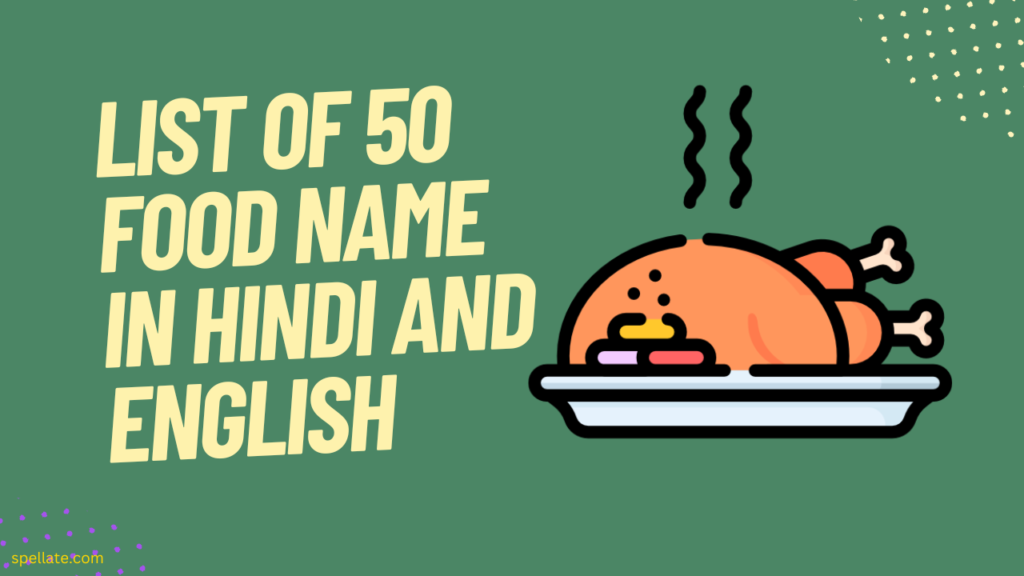
Hindi is one of the official languages spoken in India and knowing Hindi names for various foods can be helpful while traveling or ordering food. Here’s a table of 50 food names in Hindi along with their English translations that will come in handy for all the food enthusiasts out there.
| No | Hindi Food Name | English Translation |
| 1 | Rajma Chawal | Kidney Beans with Rice |
| 2 | Chole Bhature | Spiced Chickpeas with Fried Bread |
| 3 | Paneer Tikka | Grilled Cottage Cheese Cubes |
| 4 | Biryani | Fragrant Rice Dish with Meat or Vegetables |
| 5 | Samosa | Deep-fried Pastry filled with Spiced Potatoes or Meat |
| 6 | Gulab Jamun | Deep-fried Milk Dumplings Soaked in Sugar Syrup |
| 7 | Jalebi | Deep-fried Spiral-shaped Sweet Treat |
| 8 | Masala Dosa | Rice and Lentil Crepes filled with Spiced Potato Mixture |
| 9 | Butter Chicken | Creamy Chicken Curry |
| 10 | Aloo Paratha | Stuffed Whole Wheat Bread with Spiced Mashed Potatoes |
| 11 | Pani Puri/Gol Gappa | Hollow Crispy Puris Filled with Spicy and Tangy Water |
| 12 | Tandoori Chicken | Grilled Marinated Chicken |
| 13 | Palak Paneer | Spinach with Cottage Cheese |
| 14 | Dal Makhani | Creamy Lentil Dish |
| 15 | Vada Pav | Spiced Potato Fritters in a Bread Roll |
| 16 | Gajar Ka Halwa | Carrot Pudding |
| 17 | Papdi Chaat | Crispy Snack with Spiced Yogurt and Chutney |
| 18 | Malai Kofta | Creamy Cottage Cheese Dumplings in Tomato-based Gravy |
| 19 | Chicken Biryani | Fragrant Rice Dish with Chicken |
| 20 | Puri Bhaji | Deep-fried Bread with Spiced Vegetable Curry |
| 21 | Chana Masala | Spiced Chickpea Curry |
| 22 | Rabri | Sweetened Thickened Milk |
| 23 | Lassi | Yogurt-based Drink |
| 24 | Pav Bhaji | Mashed Vegetable Curry with Bread Rolls |
| 25 | Dahi Vada | Lentil Dumplings in Yogurt |
| 26 | Chicken Tikka | Grilled Marinated Chicken Pieces |
| 27 | Kheer | Rice Pudding |
| 28 | Chaat | Savory Snack with Spicy and Tangy Flavors |
| 29 | Malai Paneer | Creamy Cottage Cheese |
| 30 | Chana Dal | Split Bengal Gram |
| 31 | Aloo Gobi | Spiced Potatoes and Cauliflower |
| 32 | Matar Paneer | Peas and Cottage Cheese Curry |
| 33 | Chicken Curry | Spicy Chicken Stew |
| 34 | Chilli Paneer | Stir-fried Cottage Cheese in Spicy Sauce |
| 35 | Gobi Manchurian | Cauliflower Fritters in Tangy Sauce |
| 36 | Chicken Biryani | Fragrant Rice Dish with Chicken |
| 37 | Baingan Bharta | Smoky Mashed Eggplant |
| 38 | Rasmalai | Soft Cheese Dumplings in Sweet Milk Syrup |
| 39 | Kachori | Deep-fried Stuffed Pastry |
| 40 | Prawn Curry | Spicy Shrimp Curry |
| 41 | Dhokla | Steamed Chickpea Flour Snack |
| 42 | Chicken 65 | Spicy Fried Chicken |
| 43 | Mutton Rogan Josh | Spicy Slow-cooked Mutton Curry |
| 44 | Aloo Tikki | Spiced Potato Patties |
| 45 | Fish Fry | Fried Fish |
| 46 | Malpua | Sweet Pancakes |
| 47 | Chicken Korma | Creamy Chicken Curry |
| 48 | Baigan Ka Bharta | Smoky Mashed Eggplant |
| 49 | Rajasthani Gatte Ki Sabzi | Gram Flour Dumplings in Spiced Gravy |
Significance of food names in Hindi
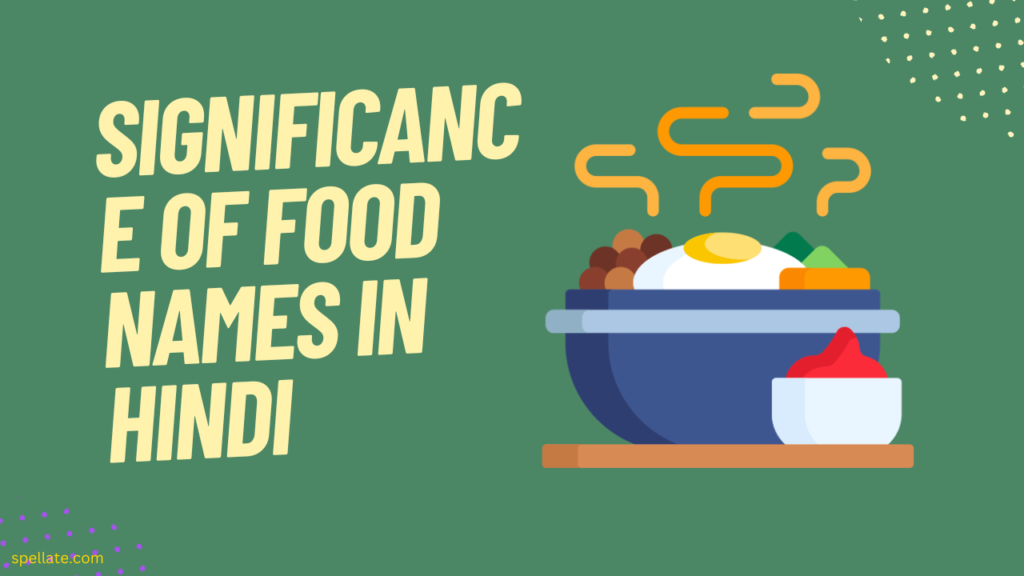
Food name in Hindi hold great significance as they not only describe the dish but also reflect the cultural and regional aspects of Indian cuisine. Here are some key significances of food name in Hindi:
Cultural Identity:
Hindi food names are deeply rooted in the cultural identity of different regions in India. They represent the diverse culinary traditions, ingredients, and cooking techniques specific to each region. For example, dishes like Rajma Chawal and Chole Bhature are popular in North India, while Masala Dosa and Sambar are associated with South Indian cuisine. The use of Hindi names helps preserve and promote the cultural heritage of various communities.
Ingredient Description:
Hindi food names often provide insights into the main ingredients used in a particular dish. For instance, Aloo Paratha indicates that the dish consists of stuffed parathas with spiced mashed potatoes, while Palak Paneer reveals the combination of spinach and cottage cheese. These descriptive names help in understanding the primary components of a dish and can assist individuals with dietary restrictions or preferences.
You May Also Like
Flavor and Texture Indication:
Hindi food names sometimes convey the flavors, textures, or cooking methods associated with a particular dish. For example, “Tandoori” in Tandoori Chicken signifies that the chicken is marinated and cooked in a traditional clay oven called a tandoor, resulting in smoky flavors and a charred exterior. The name “Malai Kofta” suggests the creamy texture of the cottage cheese dumplings in a rich tomato-based gravy. These names provide hints about the taste, appearance, and preparation techniques of the dish.
Emotional and Nostalgic Connections:
Food name in Hindi often evoke emotional and nostalgic connections. They remind people of special occasions, festivals, family gatherings, or childhood memories associated with specific dishes. The names can trigger a sense of comfort, familiarity, and attachment to the culinary traditions and heritage of India.
Regional Diversity:
India is a vast country with diverse regional cuisines. Food name in Hindi reflect the wide range of dishes from different states and communities, showcasing the culinary diversity within the country. Each region has its own unique set of food names that represent local specialties and traditional recipes, contributing to the rich tapestry of Indian cuisine.
Common ingredients in Hindi dishes
Hindi dishes often feature a variety of common ingredients that add flavor, texture, and aroma to the preparations. Here are some commonly used ingredients in Hindi cuisine:
Spices:
Spices are a cornerstone of Indian cooking, and Hindi dishes are no exception. Some common spices used in Hindi cuisine include turmeric, cumin, coriander, cardamom, cinnamon, cloves, black pepper, fenugreek, mustard seeds, and red chili powder. These spices add depth, aroma, and heat to the dishes.
Lentils and Pulses:
Lentils and pulses are widely used in Hindi cooking, providing a good source of protein and fiber. Common varieties include split chickpeas (chana dal), red lentils (masoor dal), yellow lentils (moong dal), split pigeon peas (toor dal), and black gram (urad dal). These are often used to make dal (lentil soup) and various curries.
Rice and Wheat:
Rice (chawal) and wheat (gehun) are staple grains in Hindi cuisine. Basmati rice is commonly used for biryanis, pulaos, and plain steamed rice. Whole wheat flour is used to make rotis (Indian bread) and parathas (stuffed bread).
Vegetables:
Hindi dishes make use of a wide variety of vegetables, both fresh and dried. Commonly used vegetables include potatoes (aloo), onions (pyaaz), tomatoes (tamatar), cauliflower (phool gobhi), spinach (palak), okra (bhindi), eggplant (baingan), peas (matar), and bell peppers (shimla mirch).
Dairy Products:
Dairy plays a significant role in Hindi cuisine. Milk, yogurt (dahi), and various dairy products like ghee (clarified butter), paneer (cottage cheese), and malai (cream) are used in cooking to add richness and flavor to dishes.
Nuts and Seeds:
Hindi cuisine often incorporates nuts and seeds to enhance the taste and texture of dishes. Commonly used ingredients include cashews, almonds, peanuts, sesame seeds, poppy seeds, and coconut.
Fresh Herbs and Aromatics:
Hindi dishes frequently use fresh herbs and aromatics to impart freshness and fragrance. Popular choices include ginger (adrak), garlic (lehsun), green chilies (hari mirch), cilantro (dhania), mint (pudina), and curry leaves (kadi patta).
Garam Masala:
Garam masala is a blend of ground spices commonly used in Hindi cuisine. It typically includes a mix of warming spices like cinnamon, cardamom, cloves, cumin, and black pepper. Garam masala adds a unique and aromatic flavor to various curries and rice dishes.
Misconceptions about Hindi food names
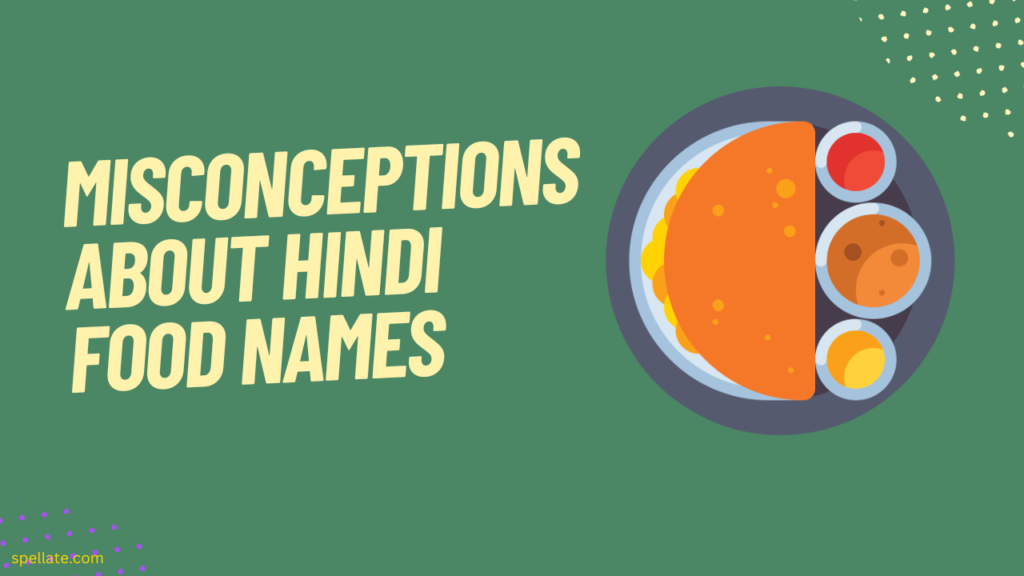
Misconceptions about Hindi food names can arise due to various reasons, including cultural unfamiliarity, misinterpretation, or generalizations. Here are some common misconceptions about Hindi food names:
Spiciness:
One common misconception is that all Hindi food is excessively spicy. While Indian cuisine is known for its bold and flavorful spices, not all dishes are fiery hot. Indian cuisine encompasses a wide range of flavors and spice levels, from mild to hot, and not every dish is inherently spicy. The heat can be adjusted according to individual preferences.
Homogeneity:
Another misconception is that all food name in Hindi is the same throughout the country. India is a diverse nation with distinct regional cuisines, and the food name in Hindi represent a fraction of the overall Indian culinary landscape. Each region has its own unique set of dishes, flavors, and cooking techniques. It is important to recognize the regional diversity within Hindi cuisine.
Vegetarian-only:
Hindi food names are often associated with vegetarian dishes. While vegetarianism is widely practiced in India, it is not the sole characteristic of Hindi cuisine. Hindi cuisine includes a variety of both vegetarian and non-vegetarian dishes, catering to diverse dietary preferences and cultural practices.
Lack of Variety:
Some people mistakenly believe that Hindi food names refer to a limited range of dishes. In reality, Hindi cuisine offers a vast array of preparations, including curries, biryanis, snacks, desserts, and more. Each dish has its own distinct ingredients, cooking methods, and flavor profiles, showcasing the culinary richness of Hindi cuisine.
Unfamiliarity with Names:
Food name in Hindi might be unfamiliar to those not well-acquainted with Indian cuisine. This lack of familiarity can lead to misconceptions or assumptions about the nature of the dishes. It is important to approach Hindi food names with an open mind and seek opportunities to explore and learn about the diverse range of flavors and ingredients they represent.
Final Thoughts
In conclusion, Hindi food names play a significant role in Indian cuisine, reflecting the cultural, regional, and descriptive aspects of the dishes. They represent the diverse flavors, ingredients, and cooking techniques that make Indian cuisine so vibrant and varied. While misconceptions about Hindi food names can arise due to cultural unfamiliarity or generalizations, it is important to approach them with an open mind and seek a deeper understanding of the culinary traditions they represent.
Hindi food names describe the dishes and evoke emotions, memories, and a sense of cultural identity. They showcase the regional diversity within India, highlighting the unique flavors and ingredients associated with each region. Additionally, Hindi food names provide insights into the primary components, flavors, and textures of a dish, helping individuals make informed choices based on their dietary preferences or restrictions.
By dispelling misconceptions and embracing the richness of Hindi cuisine, one can truly appreciate the depth and complexity of Indian culinary traditions. Exploring Hindi food names opens the doors to a world of flavors, from spicy and aromatic curries to comforting rice dishes, delightful snacks, and indulgent desserts.
Whether it’s savoring the flavors of Rajma Chawal, indulging in the crispy delight of Samosa, or relishing the sweetness of Gulab Jamun, Hindi food names invite us on a culinary journey that celebrates the heritage, diversity, and love for food deeply embedded in Indian culture.
FAQs
What is the Hindi word for food?
The Hindi word for food is “खाना” (khaana).
What is the Hindi word for vegetarian food?
The Hindi word for vegetarian food is “शाकाहारी भोजन” (shaakaahaari bhojan).
What is the Hindi word for non-vegetarian food?
The Hindi word for non-vegetarian food is “मांसाहारी भोजन” (maansaahaari bhojan).
What is the Hindi word for breakfast?
The Hindi word for breakfast is “नाश्ता” (naashta).
What is the Hindi word for lunch?
The Hindi word for lunch is “दोपहर का भोजन” (dopahar ka bhojan).
What is the Hindi word for dinner?
The Hindi word for dinner is “रात का खाना” (raat ka khaana).
What is the Hindi word for snacks?
The Hindi word for snacks is “चटपटा” (chatpata).
What is the Hindi word for dessert?
The Hindi word for dessert is “मिठाई” (mithai).
What is the Hindi word for spicy food?
The Hindi word for spicy food is “तीखा खाना” (teekha khaana).
What is the Hindi word for sweet food?
The Hindi word for sweet food is “मीठा खाना” (mitha khaana).
